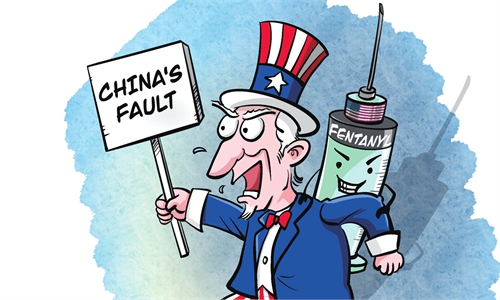Inside America’s fight against fentanyl | ABCNL
A man sits slumped in a street overrun with drug users in Kensington Philadelphia, on July 19, 2021. Photo: VCG
The US is plagued with a drug abuse problem more acute than any other countries as 12 percent of global drug users come from the North American country, two times higher than the proportion of its population.
Provisional data indicates that nearly 110,000 Americans died of drug overdoses in 2022, the highest of all time, and more than two-thirds of the deaths involved the powerful synthetic opioid fentanyl, as per US Centers for Disease Control and Prevention.
Fentanyl-related deaths among children increased more than 30-fold between 2013 and 2021, the Associated Press reported.
US Commerce Secretary Gina Raimondo, when visiting China in late August, claimed that US hopes to cooperate with China to tackle the rapidly increasing rates of fentanyl overdoses. However, the country simultaneously keeps scapegoating China on the issue, imposing sanctions and filing criminal charges against Chinese enterprises and individuals.
Through an investigation into the US' opioid crisis which reveals the country's legislative and law enforcement failures over the decades, the Global Times found that the US is disinclined to find a radical cure, while scapegoating China as a conduit for mounting anger in American society. All this serves the US' strategic rivalry with China.
Painkiller becomes source of pain
There is nothing new under the sun, and the US' fentanyl crisis is a continuation of its forbearer Oxycodone, a strong, semi-synthetic opioid used to treat moderate to severe pain.
The Netflix TV drama Painkiller released in 2023, adapted from a book published in 2003, revealed how the pharmaceutical company Purdue Pharma colluded with US medicinal regulators and developed aggressive marketing tactics to promote its brand name product OxyContin, an extended-release form of Oxycodone, as less likely to cause addiction, raking in tens of millions of dollars.
The US Food and Drug Administration (FDA), charged with the responsibility of prescription drug use regulation, gave OxyContin the green light in 1995 even though neither long-term studies nor assessments of its addictive capabilities had been thoroughly conducted.
Two principal FDA reviewers who originally approved Purdue's application both took positions at the company after leaving the agency. In the following two decades, more FDA staffers involved in opioid approvals left the FDA to work for opioid makers, according to the American Medical Association Journal of Ethics.
Purdue offered kickbacks, paid lecturers, and organized free seminar vacations to doctors to incentivize them to prescribe OxyContin, leading to a tenfold increase in prescriptions for less serious pain, from about 670,000 in 1997 to about 6.2 million in 2002.
Suspected fentanyl pills are seized at the Los Angeles International Airport Los Angeles, California, on October 19, 2022. Photo: VCG
As Purdue earned billions of dollars from oxycodone sales, other drug companies took note; when the numerous unnecessary prescriptions were given to chronic pain patients, addiction and overdose deaths soared.
The US' healthcare system also contributed - "Most insurance, especially for poor people, won't pay for anything but a pill," said Judith Feinberg, a professor at West Virginia University with expertise in infectious diseases associated with drug injection.
The US Department of Health and Human Services estimated that about 11 million people in the US consume oxycodone in a non-medical way annually.
Although Purdue was ultimately brought to justice, addicts are not redeemed. The large, ever expanding group of drug dependence, without proper social support and intervention, easily became the victims of new, more powerful drugs - fentanyl, a synthetic opioid which is also FDA-approved and up to 50 and 100 times stronger than heroine and morphine respectively.
Fentanyl, the cheaper to make yet more lethal drug and its close cousins became the biggest drug-related killers in the US in 2016, the Associated Press reported.
The media has reported on how drug users addicted to other substances unknowingly ingest fentanyl, as local dealers sell "traditional" products like cocaine "cut" with fentanyl, or pills containing fentanyl that are "advertised as legitimate prescription drugs."
Incapable legislation, enforcement
With around 4 percent of the world's population, the US consumes 80 percent of the world's opioids.
Why is the US?
The US' drug problem, including the current fentanyl abuse crisis, is deeply rooted in the country's lobbying political structure and ideology, said Zhang Yifei, an associate research fellow at the Institute of American Studies under the Chinese Academy of Social Sciences.
The colossal profits bundle pharmaceutical companies with the FDA, sponsored politicians, academic groups, and the media, making the fentanyl crisis a predictable tragedy in the US that has enriched a few at the expense of many lives lost, Zhang said.
Academic institutions provide "scientific proof," media and think tanks propagate said proof, and drug makers lobby the government - this is a very complete and mature chain, Zhang elaborated, "They have various ways to exchange rights and interests through the 'revolving door' system."
Zhang also pointed to "the pan-liberalism trend in the US, which emphasizes the absolute freedom of individuals."
US governments, be they federal or state, are incapable of exercising effective regulation on many issues, although some of them, like drugs and guns, have endangered the public, Zhang said.
When the public demands for freedom of marijuana use, governments and drug companies "hear" these calls and legalize the drug, milking profits from sales. Even in states where marijuana remains illegal, its use is prevalent and law enforcement efforts to curb use are almost nonexistent.
A Chinese national who used to live in North Carolina, told the Global Times that it is common to see people "getting high" in public in broad daylight when the drug is illegal.
In the same way, only until the fentanyl crisis becomes so critical that the public demands for action to be taken, will the government finally act. The first fentanyl-related act passed in Congress in 2017, four years after lawmakers receiving alert on the drug.
A woman uses a new vending machine in Brooklyn that will disperse fentanyl test strips and naloxone as well as hygiene kits, maxi pads, Vitamin C, and COVID-19 tests for free on June 5, 2023 in New York City. Photo: VCG
When actions are finally taken, they cannot avoid the trap of US' political wrestling.
Lawmakers, during the US' 2023 legislative session, introduced over 600 bills related to fentanyl. However, in a deeply divided country, many of the fentanyl crime laws are notable for attracting bipartisan support, the New York Times reported in June. When Republican-controlled House reviewed a bill on fentanyl trafficking in May, 132 of the 133 vetoes came from Democrats.
Another incongruous approach is the use of "safer" supervised consumption services (SCS) through which people can use pre-obtained drugs "safety" with the support of trained personnel. Funded by public money, it is hard to say whether such facilities can curb overdoses more than treating those with an addiction, not to mention such "legal sites" can mislead youth to believe addiction and drug use are nothing to worry.
Zeng Lidu, a grassroots narcotic control officer in Central China's Hunan Province, told the Global Times that the US approach of control sounds "odd" in China, which, as one of the countries with the most effective drug control, closely monitors the maker rather than potential user.
"Fentanyl has variable structures, making it more difficult than the traditional drugs to crack down on," Zeng told the Global Times. "In our district, only a few chemical plants and hospitals are allowed the use of fentanyl under close supervision. We trace and regulate every step in their use, transportation, and storage of fentanyl."
Experts told the Global Times that many fentanyl precursors are widely used in the chemical industry. China, as a chemical giant, does not have a fentanyl abuse problem at home, which says a lot about the root cause of the American drug disease.
Not cooperation but scapegoating
Out of humanitarianism, China is willing to cooperate with the US in tackling the proliferation of fentanyl and has established a cooperation mechanism with the US on the issue.
China scheduled and controlled all fentanyl-related substance by class in 2019 - the first country to do so in the world, while the US itself is yet to do the same. China formulated three legal documents to support the filing, prosecution, conviction, and sentencing of offenses involving these substances. To reinforce fentanyl testing and monitoring, five sub-centers of the National Drug Laboratory have been established across the country.
But the US in 2020 unilaterally and arbitrarily imposed sanctions on the institute of forensic science under China's Ministry of Public Security and National Drug Laboratory, severely jeopardizing related cooperation.
A new vilification of China popular in the US is that Chinese firms sell commonly used chemicals to a third country, such as Mexico, where fentanyl is manufactured and later sold to the US. Citing this, the US has sanctioned Chinese companies, even including tablet press machine makers.
Analysts stressed the "know your customer" practice that some in the US have been asking about far exceeds UN obligations. According to international practices, it is up to the importing country to ensure that imported goods are not used for illegal purposes, not the exporter. China has no sovereign right over a third country, and Chinese companies are not capable of verifying all buyers of its product.
Zhang Yifei said scapegoating China on fentanyl is an easy and convenient approach for the US government to unleash domestic anger against ineffective drug control.
Through distorted coverage on the issue, domestic media outlets successfully sell "China responsible" narrative to Americans at home. By repeatedly hyping the narrative at international occasions, the US also adds fentanyl into its recipe cooking "China threat."
In this sense, fentanyl is essentially same to long-term smear campaign against China on many topics including human rights in Xinjiang region, Zhang said.
As the presidential elections approach, blaming China for its domestic social handicaps as a political tactic sounds ridiculous, but quite a number of US politicians and voters buy this logic, Zhang noted. As the US' domestic political infighting escalates, chance of cooperation on this area which the US is in urgent need of, may narrow even further.
Related posts:
How Metadichol® Can Transform Your Health and Wellness
















